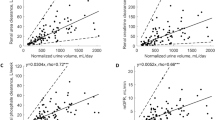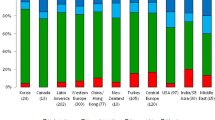Abstract
Objective: To analyze the effect of age on nutrition indices in subjects on the same continuous ambulatory peritoneal dialysis (CAPD) schedule. Methods: We analyzed 613 sets of clearance values and nutrition indices in 302 CAPD patients. Small solute clearances included urea clearance (Kt/Vurea) and creatinine clearance (Ccr). Nutrition indices included body mass index (BMI), serum albumin, urea and creatinine, 24-h urea nitrogen and creatinine excretion in urine plus dialysate, protein nitrogen appearance (PNA), PNA normalized by standard weight (nPNA), lean body mass (LBM) computed by creatinine kinetics, and LBM/Weight. CAPD subjects were classified in 4 age quartiles (Q): Group Q1, age 33.7 ± 7.6 years, N = 149; group Q2, age 49.5 ± 3.8 years, N = 158; group Q3, age 61.5 ± 2.6 years, N = 154; and group Q4, age 72.1 ± 5.4 years, N = 152. Group comparison was done by one-way ANOVA or chi-square. Predictors of low nutritional parameters were identified by logistic regression. Selected variables were compared by linear regression. Results: Mean Kt/Vurea and Ccrwere above the current adequacy standards and did not differ between the age quartiles. In contrast, older quartiles had, in general, lower nutrition indices than younger quartiles. However, the youngest quartile had the lowest BMI. By logistic regression, young age was a predictor of low BMI, while advanced age was a predictor of low creatinine and urea nitrogen excretion, low nPNA, and low LBM/Weight. The regressions of nPNA on Kt/Vurea differed between the age quartiles. By these regressions, the youngest quartile had higher nPNA values for the same Kt/Vurea than the oldest quartile in the clinically relevant range of Kt/Vurea and nPNA values. Conclusions: Nutrition indices are worse in older than in younger CAPD patients with the same small solute clearances. Nutrition of CAPD patients is adversely affected by age and requires special attention in the older age group.
Similar content being viewed by others
References
U.S. Renal Data System. USRDS 1999 Annual Data Report. National Institute of Health, National Institute of Diabetes and Digestive and Kidney Diseases, Bethesda, MD, April 1999, pp. 25–38.
Ibid., pp. 39–56.
Ross CJ, Rutzik EA. Dialysis modality selection in the elderly patient with end-stage renal disease: Advantages and disadvantages of peritoneal dialysis. Adv Perit Dial, 1990, 6,Suppl. Peritoneal Dialysis in the Elderly: 11–17.
Maiorca R, Cancarini GC, Camerini C, Manili L, Brunori G. Modality selection in the elderly. Medical factors. Adv Perit Dial 1990; 6,Suppl. Peritoneal Dialysis in the Elderly: 18–25.
Nolph KD, Lindblad AS, Novak JW, Steinberg SM. Experiences with the elderly in the National CAPD Registry. Adv Perit Dial, 1990; 6,Suppl. Peritoneal Dialysis in the Elderly: 33–37.
Bloembergen WE, Port FK, Mauger EA, Wolfe RA. A comparison of mortality between patients treated with hemodialysis and peritoneal dialysis. J Am Soc Nephrol 1996; 6: 177–183.
Blake PG, Flowerdew G, Blake RM, Oreopoulos DG. Serum albumin in patients on continuous ambulatory peritoneal dialysis. Predictors, and correlation with outcomes. J Am Soc Nephrol 1993; 3: 1501–1507.
Malhotra D, Tzamaloukas AH, Murata GH, Fox L, Goldman RS, Avasthi PS. Serum albumin in continuous peritoneal dialysis: Its predictors and relationship to urea clearance. Kidney Int 1996; 50: 243–249.
Golper T, Churchill D, Burkart J, Firanek C, Geary D, Gotch F et al. NKF DOQI. Clinical practice guidelines for peritoneal dialysis adequacy. Am J Kidney Dis 1997; 30(Suppl. 2): S67–136.
Nolph KD, Moore HL, Twardowski ZJ, Khanna R, Prowant B, Meyer N et al. Cross sectional assessment of weekly urea and creatinine clearance in patients on continuous ambulatory peritoneal dialysis. ASAIO J 1992; 38: M139–142.
Tzamaloukas AH, Murata GH, Malhotra D, Fox L, Goldman RS, Avasthi PS. The minimal dose of dialysis required for a target KT/V in continuous peritoneal dialysis. Clin Nephrol 1995; 44: 316–321.
Tzamaloukas AH, Murata GH, Malhotra D, Fox L, Goldman RS, Avasthi PS. Creatinine clearance in continuous peritoneal dialysis: Dialysis dose required for a minimal acceptable level. Perit Dial Int 1996; 16: 41–47.
Watson PE, Watson EG, Butt RD. Total body water for adult males and females estimated from simple anthropometric formulae. Am J Clin Nutr 1980; 33: 27–39.
Dubois B, Dubois EF. A formula to estimate the approximate body surface area if height and weight be known. Arch Intern Med 1916; 17: 863–871.
Bhatla B, Moore HL, Nolph KD. Modification of creatinine clearance by estimation of residual urinary creatinine and urea clearance in CAPD. Adv Perit Dial 1995; 11: 101–105.
Keshaviah PR, Nolph KD, Khanna R, Prowant B, Emerson PF, Meyer M et al. Lean body mass estimated by creatinine kinetics. J Am Soc Nephrol 1994; 4: 1474–1485.
Twardowski ZJ, Nolph KD, Khanna R, Prowant BF, Ryan LP, Moore HL et al. Peritoneal equilibration test. Perit Dial Bull 1987; 7: 138–147.
Tzamaloukas AH, Murata GH, Piraino B, Rao P, Bernardini J, Malhotra D et al. Peritoneal urea and creatinine clearances in continuous peritoneal dialysis patients with different types of peritoneal solute transport. Kidney Int 1998; 53: 1405–1411.
Tzamaloukas AH, Murata GH, Harford AM, Sena P, Zager PG, Eisenberg B et al. Hand gangrene in diabetic patients on chronic dialysis. ASAIO Trans 1991; 37: 638–643.
Oreopoulos DG. The aging kidney. In Adv Perit Dial 1990; 6,Suppl. Peritoneal dialysis in the geriatric patient: 2–5.
Nissenson AR. Dialysis therapy in the elderly. Kidney Int 1993; Suppl. 40: S1–7.
Avram MM, Fein PA, Bonomini L, Mittman N, Loutoby R, Avram DK et al. Predictors of survival in continuous ambulatory peritoneal dialysis patients: A five-year prospective study. Perit Dial Int 1996; 16(Suppl. 1): S190–194.
Malhotra D, Murata GH, Tzamaloukas AH. Serum albumin in peritoneal dialysis: Clinical significance and important influences on its levels. Int J Artif Organs 1997; 20: 251–254.
Jones MR. Etiology of severe malnutrition: Results from an international cross-sectional study in continuous ambulatory peritoneal dialysis patients. Am J Kidney Dis 1994; 23: 412–420.
Harty J, Farager B, Venning M, Gokal R. Urea kinetic modeling exaggerates the relationship between nutrition and dialysis in CAPD patients (the hazards of cross-sectional analysis). Perit Dial Int 1995; 15: 105–109.
Blake PG. The problem of mathematical coupling: How can statistical artifact and biological causation be separated when relating protein intake of clearance in ‘predialysis’ and dialysis patients? Perit Dial Int 1997; 17: 431–434.
Bergstrom J, Furst P, Alverstrand A, Lindholm B. Protein and energy intake, nitrogen balance and nitrogen losses in patients treated with continuous ambulatory peritoneal dialysis. Kidney Int 1993; 44: 1048–1057.
Shimomura A, Tahara D, Azekura H, Matsuo H, Kamo M. Key factors to improve survival of elderly patients on CAPD. Adv Perit Dial 1992; 8: 166–172.
Nolph KD, Moore HL, Prowant B, Meyer M, Twardowski ZJ, Khanna R et al. Age and indices of adequacy and nutrition in CAPD patients. Adv Perit Dial 1993; 9: 87–91.
Cancarini G, Constantino E, Brunori G, Manili L, Camerini C, Spitti C et al. Nutritional statistics in long-term CAPD patients. Adv Perit Dial 1992; 8: 84–87.
Cameron ML, Piraino B. Relationship of protein nitrogen appearance rate and KT/V in elderly PD patients (abstract). ASAIO Abstracts 1994; 23: 106.
Tzamaloukas AH, Murata GH, Bernardini J, Malhotra D, Rao P, Piraino B et al. Gender differences in normalized clearances in CAPD: Role of body size and normalizing parameters. Perit Dial Int 1999; 19: 165–169.
Tzamaloukas AH, Murata GH, Malhotra D, Rao P, Piraino B, Bernardini J et al. Small solute clearances in diabetic subjects on continuous ambulatory peritoneal dialysis: Comparison to nondiabetic subjects. Adv Perit Dial 1999; 15: 179–182.
Murata GH, Tzamaloukas AH, Malhotra D, Saddler MC, Fox L, Wood B et al. Protein catabolic rate in patients on peritoneal dialysis: Its predictors and association with urea clearance indices. ASAIO J 1996; 42: 46–51.
Tzamaloukas AH, Murata GH, Piraino B, Malhotra D, Bernardini J, Rao P et al. The relation between body size and normalized small solute clearances in continuous ambulatory peritoneal dialysis. J Am Soc Nephrol 1999; 10: 1575–1581.
Churchill DN, Thorpe KE, Nolph KD, Keshaviah PR, Oreopoulos DG, Page D. Increased peritoneal membrane transport is associated with decreased patient and technique survival for continuous peritoneal dialysis patients. J Am Soc Nephrol 1998; 9: 1285–1292.
Cueto-Manzano AM, Correa-Rotter R. Is high peritoneal transport rate an independent risk factor for CAPD mortality? Kidney Int 2000; 57: 314–320.
Author information
Authors and Affiliations
Rights and permissions
About this article
Cite this article
Tzamaloukas, A., Oreopoulos, D., Murata, G. et al. The relation between nutrition indices and age in patients on continuous ambulatory peritoneal dialysis receiving similar small solute clearances. Int Urol Nephrol 32, 449–458 (2001). https://doi.org/10.1023/A:1017579105158
Issue Date:
DOI: https://doi.org/10.1023/A:1017579105158




